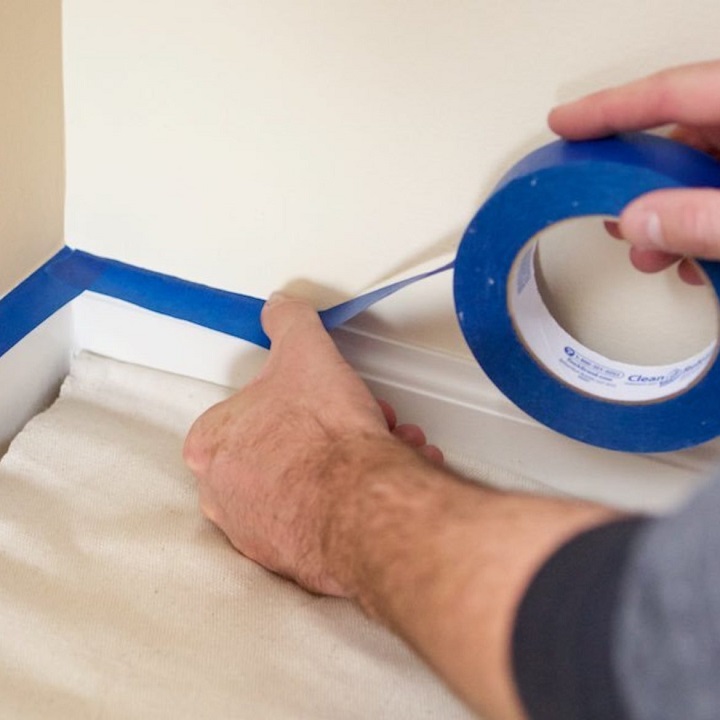How to Choose and Use Masking Tape
Contents
If you are trying to choose which masking adhesive tape to buy for your next project or task, you need to learn about the different types and their performances. The short answer is that you’ll have to choose according to the kind of operation you are performing. Painter’s tape, for instance, is also known as masking tape and it’s used primarily for painting, more specifically for masking off areas that should not be painted or helping painters create a straight line, but it has many more applications.
This common type of masking tape is made of a thin, easy to tear backing material, which is often thin crepe paper, and a pressure-sensitive adhesive. This means that both the backing material and the adhesive can be easily removed. It’s one of the most popular types of tape amongst both professional and everyday people. Namely, it’s used by painters, decorators, everyday people doing do-it-yourself projects, enthusiasts for different hobbies, etc.
This simple but very useful item was invented nearly a century ago by Richard Drew, who also invented the Sellotape. At the time when he invented them, the American worked at the 3M Company, a company that went through a lot of phases, and at that moment was producing sandpaper. Today, 3M is a multinational corporation operating across different fields.

Choosing a Masking Tape
This useful pressure-sensitive 3M adhesive tape has a wide variety of applications in many everyday situations, as well as in different types of work tasks. It can be as easily removed as it can be applied, and it won’t leave any residue. Aside from protecting stuff from paint or keeping paint away, helping get a straight line with the paint, or making different patterns and designs with different paints, painter’s tape can be used to label stuff, hang lightweight items, which you want easily removed, mark stuff on surfaces you want to protect from adhesive residue, support an item which is being glued as the glue is drying off, etc.
Masking tape can be categorised by different things, and in order to choose the right one, it’s important to understand the differences between them. They come in different widths, colours, materials, as well as strengths of the adhesive, and each of those can be better for different kinds of applications and environments.
Of course, when you are choosing a painter’s tape, the best way to determine if the specific tape is good for your task is to read the label and learn how flexible it is, how sticky it is, how much it costs and how long it is.
Colours
Masking tape is available in a number of different colours, from white to bright colours and black. Colour doesn’t always play an important role but there is some meaning to the colour of the tape. Some colours may indicate specific properties, while others are chosen simply for convenience.
White and other light colours are the most popular colours for masking tapes. They’re discreet and great for everyday applications, such as labelling boxes and containers. They’re used by both professionals and decorators, people doing DIY projects and hobbyists. Bright colours are great for colour coding projects. Blue and yellow are often used by painters for their visibility because they are great for marking where to apply colour.

Adhesive Materials
To determine anything about the 3M tape you need, you have to understand your project. Regardless of whether you need it for a do-it-yourself project at home, or you need it for work, you want to choose the right type of masking tape for your task. One way to categorise masking tapes is by the adhesive material used to make them. There are three commonly used types of adhesive: rubber or rubber resin-based, acrylic-based and silicone-based masking tape adhesive. Each is better for some tasks than the others.
Rubber-based masking tapes are great for everyday applications, as they’re reliable and stick great. However, they have the lowest level of temperature resistance.
Acrylic-based masking tapes are very adaptable, making them suitable for more harsh environments and extreme temperatures. Further, they are highly versatile, and can perform well even under fluctuating temperatures from below zero to around 150° Celsius.
Silicone-based masking tapes offer the most resistance against extreme temperatures. They can withstand extremely high temperatures, as high as 260° Celsius if the backing material isn’t flammable like crepe paper.
Adhesion Levels
Different types of masking tape offer different levels of stickiness. However, unlike the typical duct tape uses, this type of tape isn’t meant to be used for packing, holding things together securely, or reinforcement.
Generally, the masking tapes with lower adhesiveness are good for things like labelling, as well as freshly painted items or wallpapers for protection. Medium-high adhesiveness ensures that the tape stays secure on materials such as concrete or brick, while higher stickiness is great for smoother surfaces. For outdoor projects, your masking tape needs to be resistant to moisture and humidity, as well as high temperatures.

Applying and Removing Masking Tape
One of the best things about the very convenient 3M masking tape is that it is fairly easy to use. Of course, you need to be careful if you need to be more precise with its application, such as having to place a straight line or a highly precise finish. It’s pressure-sensitive, so depending on the project you need it for, you may need to press harder if you need it to stick more.
When you finish your project, you need to remove the masking tape. However, if you’ve used it for painting, you should let the paint dry before removing the tape. Don’t leave it for too long either, because otherwise, it may take the paint off.









